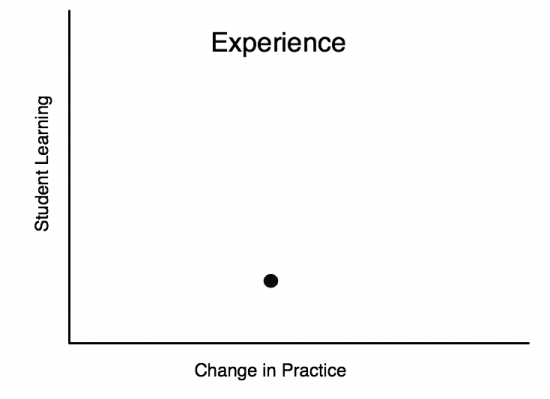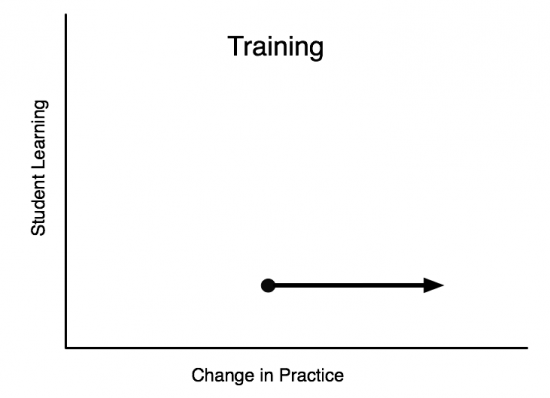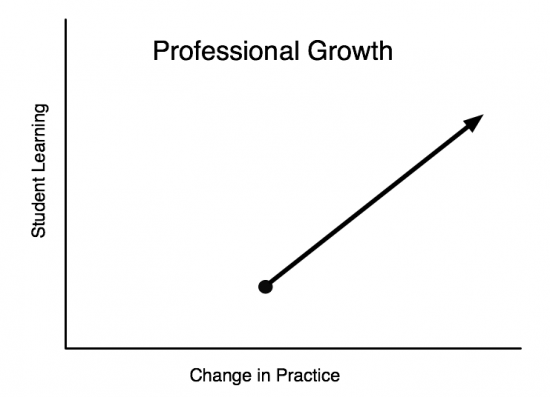Disclaimer—- believe it or not this is really worth reading and thinking about if you have anything to do with staff dev or have been the victim of hit and run staff dev in the past. Arm yourself and be ready to counterattack in the future. 1
This idea is the brainchild of our director of staff development, Chris Corallo2. I believe that this structure has the potential to really change the conversation around staff development in schools.
We are putting it out into the wild under a Creative Commons Attribution-Noncommercial-Share Alike license. Which is a cool and good thing for him to authorize.
So I’ve excerpted the document below. It’s available in full here.
There are three types of staff development- experiences, training and professional growth. These simple buckets will help you have a conversation that gets you somewhere else. Most people want to provide professional growth but deliver experience or training. These buckets allow you to show people that and move towards staff dev that’s longer term and more focused on changing practice and impacting learning.
Experience

This is an opportunity to explore new learning without making any commitment to implementation or change in practice and/or with no expectation of impacting student learning.
Training
This type is typically required to carry out management or process tasks. There is a level of expectation that the new learning will change practice in someway, but with no direct link to or measurement of student learning.
Professional Growth
There is an expectation that the new learning will be implemented (with appropriate support) in the classroom to change teacher practice. There is also an expectation that this change in practice impact student learning.
Professional Growth Cycle– In order to both change practice and impact student learning, the following cycle should be implemented:
Assess: Review of data to identify the need for improved student learning.
Learn: Engage in new learning to meet the need.
Implement: Receive support for implementing new learning.
Reflect: Continually collect data and monitor outcomes of implementation of the new learning to determine if it is meeting the goal.
Assess: Revisit the data to identify further need for improved student learning.
The following is an example of how staff development on one topic can be seen through the three types of staff development. The only difference between each type is the expected outcomes in terms of teacher practice and impact on student learning.
EXPERIENCE:
At the opening of school the principal wants to set a warm tone for the school year and decides to do an activity around communication and building relationships. She uses the Whale Done video series and has the teachers talk about the video in small groups. She then leads the faculty in a team building exercise with the hopes that everyone will leave the meeting feeling like a member of the team.Scaffolding: None
Outcome: Immediately following the team building exercise the faculty members feel like a team.
Expectation for Student Learning: None
Expectation for Change in Practice: NoneTRAINING:
At the opening of school the principal wants to set a warm tone for the school year and decides to do an activity around communication and building relationships. She selects this because she believes her teachers often take a combative tone with each other as well with parents and students. The principal decides to introduce the Whale Done video series and has the teachers talk about the video in small groups.Scaffolding: She shares with the faculty her desire to see more positive interactions and asks if they would be willing to continue work on this. The faculty agree to continue working with the Whale Done series as a faculty. At the first staff development day the principal brings in a Whale Done trainer who focuses attention on the three tenets of the programs communication model. Faculty are trained in the steps to implement the model. The faculty makes a commitment to each other to use the model in working with each other. They also all agree to give permission to be “coached” in the model, which means that each teacher has the right to remind others of the model when their specific behavior does not match the model protocol.
Outcome: Teachers will initiate more positive interactions.
Expectation for Student Learning: None
Expectation for Change in Practice: NoneProfessional Growth: A school leadership team is examining its end of year data and determines that they have a school-wide discipline problem. The principal wonders if this issue is created by poor relationships between teachers and students. At the opening of school the principal wants to set a warm tone for the school year and decides to do an activity around communication and building relationships. She uses the Whale Done video series and has the teachers talk about the video in small groups. As part of the group discussion the teachers review student behavior data (discipline referrals) to identify issues. They discover a large number of referrals for inappropriate and disrespectful comments made to teachers. In relating this to the video they watched the teachers decide to delve more deeply into the Whale Done concepts with hopes that, if they improve their communication skills and are able to build relationships, there will be less student discipline issues.
On the first full staff development day, faculty are trained in the steps to implement the model. The faculty also makes a commitment to each other to use the model in working with each other and students. They all agree to give permission to be “coached” in the model, which means that each teacher has the right to remind others when their specific behavior does not match the model protocol. In fact, they pair up and periodically do short observations of each other in the classroom to provide feedback about their use of the Whale Done model with students. At monthly team meetings they review student discipline data to monitor their progress toward meeting their goal. If they have students who seem to be having specific behavior problems they may coach the teacher in how to work with the student.
After reviewing the discipline data with all the teams and getting feedback from the teachers, the principal sets up the next staff development day to delve more deeply into one of the parts of the Whale Done program. The entire faculty get additional training in “redirecting energy.” The teachers recommit to the process and continue their classroom observations and team meetings. At the end of the year they revisit their goal for improved student behavior to see if they met their goal of reducing the number of discipline referrals.

This work is licensed under a Creative Commons Attribution-Noncommercial-Share Alike 3.0 United States License.




Thanks for the clear examples. I’ve been trying to “bucketize” my staff dev day in Oct, and this helps clear up my thinking. I plan on offering all three types, so this explanation will help me with the teachers.